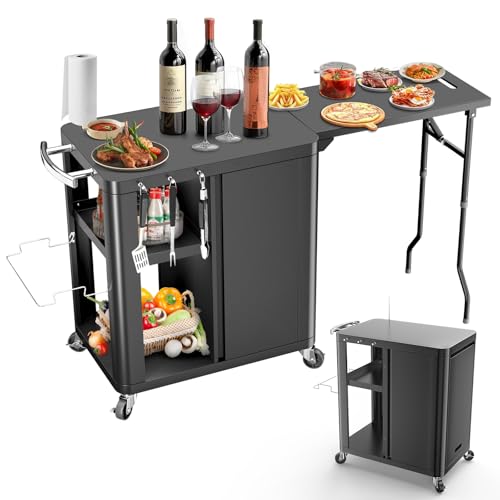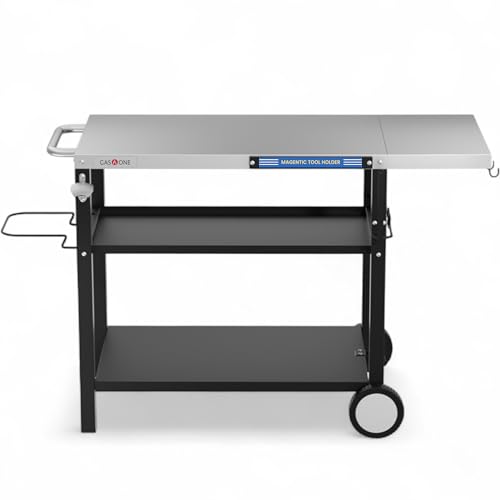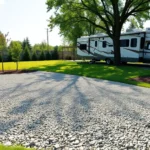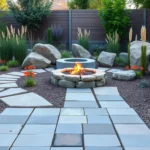We’ve all dreamed of creating the perfect outdoor cooking space where summer gatherings become unforgettable memories. A well-designed backyard grill station transforms your outdoor area into a culinary paradise that’ll make your neighbors jealous and your family thrilled.
Today’s outdoor kitchen trends go far beyond a simple barbecue setup. We’re talking about complete grill stations that combine functionality with style – think built-in grills, prep counters, storage answers and entertainment areas all seamlessly integrated into your backyard design. These outdoor cooking spaces aren’t just for weekend warriors anymore.
Whether you’re working with a sprawling patio or a cozy deck we’ll show you how to maximize your space and budget. From DIY-friendly projects to luxury installations our carefully curated backyard grill station ideas will help you create an outdoor kitchen that perfectly matches your lifestyle and cooking ambitions.
Planning Your Dream Backyard Kitchen Grill Station Layout
Smart planning transforms your outdoor cooking dreams into reality. We’ll explore the essential elements that create a functional and stunning grill station that works for your exact space and needs.
Choosing the Perfect Location for Your Outdoor Cooking Space
Proximity to your home’s kitchen makes outdoor cooking more efficient and enjoyable. We recommend placing your grill station within 15-20 feet of your indoor kitchen to simplify food transport and reduce walking time during meal preparation.
Wind patterns significantly impact your cooking experience and safety. Position your grill station so prevailing winds carry smoke away from your home, outdoor seating areas, and neighboring properties. Most regions experience consistent wind directions that you can identify by observing your yard throughout different seasons.
Utility access determines your grill station’s functionality and installation costs. We suggest selecting locations near existing electrical outlets, gas lines, or water sources to minimize expensive utility extensions. Running new gas lines can cost $500-$1,500 depending on distance and complexity.
Sun exposure affects both cooking comfort and food safety throughout the day. We recommend areas with partial shade during peak afternoon hours to keep cooks comfortable while maintaining adequate lighting for evening meal preparation.
Measuring and Mapping Your Available Space
Accurate measurements prevent costly mistakes and ensure proper equipment fit. We start by measuring the total available area using a tape measure, then create a scaled drawing on graph paper where each square represents one foot of actual space.
Clearance requirements vary by grill type and local building codes. Most jurisdictions require 3 feet of clearance from combustible materials and 10 feet from property lines for permanent installations. Gas grills need additional clearance for tank storage and connection access.
Equipment dimensions must align with your planned layout before making purchases. Standard built-in grills range from 24-42 inches wide, while portable units typically measure 18-30 inches. We always add 6 inches to manufacturer specifications for comfortable operation space.
Future expansion considerations save money and effort during initial planning. We recommend allocating 20% additional space beyond immediate needs to accommodate potential additions like side burners, refrigeration units, or expanded counter space.
Considering Traffic Flow and Safety Requirements
Primary pathways should measure at least 4 feet wide to allow comfortable movement during cooking and entertaining. We design main walkways that connect your grill station to the house, dining areas, and any pool or garden features without creating bottlenecks.
Work triangle efficiency applies to outdoor kitchens just like indoor spaces. Position your grill, prep area, and storage within 4-9 feet of each other to minimize steps during cooking while maintaining adequate workspace between each station.
Emergency access ensures safety during accidents or equipment malfunctions. We always maintain clear pathways to fire extinguishers, water sources, and indoor access points. These routes should remain unobstructed by furniture, planters, or temporary decorations.
Guest circulation requires separate zones for cooking and socializing activities. Create defined spaces where guests can gather comfortably without interfering with food preparation or creating safety hazards near hot surfaces and open flames.
Essential Components for a Functional Grill Station Setup
Building a successful outdoor grill station requires careful selection of key components that work together seamlessly. Each element contributes to creating a space that’s both functional and enjoyable for outdoor cooking adventures.
Selecting the Right Grill Type for Your Needs
Gas grills offer the convenience most homeowners crave with quick heat and precise temperature control. They’re perfect for weeknight dinners when you want to fire up the grill without waiting for charcoal to heat.
Charcoal grills deliver that authentic smoky flavor traditional barbecue enthusiasts love. These grills require more attention and time but reward you with incredible taste that gas simply can’t match.
Built-in grills create a permanent centerpiece when integrated into stone or concrete islands. They transform your backyard into a true outdoor kitchen that feels like a natural extension of your home.
Power burners expand your cooking possibilities beyond grilling to include boiling, wok cooking, and sautéing. Multi-functional setups might feature teppanyaki attachments or flat top grills for even more versatility.
Installing Proper Counter Space and Prep Areas
Counter space should be positioned adjacent to your grill for seamless food preparation and plating. We recommend at least 2-3 feet of counter space on each side of the grill for comfortable cooking.
L-shaped or U-shaped grill islands maximize workspace while creating defined cooking zones. These configurations give you room to prep ingredients, plate finished dishes, and keep cooking tools within easy reach.
Durable materials like flagstone or concrete countertops ensure your prep areas withstand weather and heavy use. These surfaces resist stains, heat damage, and moisture better than traditional indoor materials.
Covered areas or pergolas provide shade that makes prep work comfortable even during hot summer days. Adding overhead protection extends your cooking season and protects both you and your equipment.
Adding Storage Answers for Tools and Supplies
Built-in cabinets and drawers under the counter keep grilling tools, utensils, and cleaning supplies organized and accessible. Strategic placement of storage prevents clutter while maintaining a clean appearance.
Double access doors in grill islands improve functionality by allowing easy access from multiple angles. This design feature makes retrieving items faster and more convenient during busy cooking sessions.
Dedicated compartments for propane tanks ensure safe storage while keeping fuel sources hidden from view. Trash pull-outs and outdoor refrigerator spaces add convenience that rivals indoor kitchens.
Weatherproof materials protect your supplies from rain, snow, and temperature extremes. Stainless steel hardware and marine-grade finishes ensure your storage answers last for years without deterioration.
Creative Design Ideas for Stylish Outdoor Kitchen Aesthetics
We can elevate our backyard grill station from basic to breathtaking with thoughtful design choices that marry form and function. Creating a stylish outdoor kitchen aesthetic requires balancing visual appeal with practical durability.
Incorporating Natural Stone and Brick Elements
Natural stone transforms any grill station into a timeless centerpiece that complements our outdoor environment. We’ve found that authentic stone materials offer unmatched durability and rustic charm, though concrete panels textured to mimic natural stone provide a practical alternative at lower cost.
Combining authentic or faux stone with brick creates visually rich textural contrast that enhances our outdoor kitchen’s appeal. These materials work beautifully together, with stone providing smooth surfaces for countertops while brick adds warmth and character to walls and accent features.
Weather resistance becomes a key advantage when we choose these materials, as both stone and brick naturally withstand outdoor conditions better than many alternatives. Concrete panels with integrated finishes offer the same visual impact while providing superior resistance against weather and wear.
Using Weather-Resistant Materials and Finishes
High performance concrete panels with fully integrated finishes give us strong protection against weather while allowing customizable natural stone appearances. These materials resist fading, cracking, and moisture damage that can plague lesser options.
Cedar strips combined with metal studs and concrete boards create durable frameworks that we can finish with exterior grade paints like Sherwin Williams Pure White. This combination provides both structural integrity and visual appeal that lasts through seasons of outdoor cooking.
Weatherproof cabinetry ensures our investment stays protected while pull out trash bins and stainless steel appliances maintain their functionality even though exposure to elements. We recommend choosing materials specifically rated for outdoor use rather than adapting indoor products.
Blending Your Grill Station With Existing Industry
Strategic positioning near landscaping features such as flower beds, trees, or pergolas creates inviting gathering spaces that feel naturally integrated. We can enhance both aesthetics and usability by incorporating our grill station into existing outdoor living areas.
Stone or brick colors and textures should harmonize with garden paths, patios, or natural stone walls already present in our industry design. This coordination creates seamless visual flow that makes our outdoor kitchen feel like a natural extension of our property.
Covered stations or partial enclosures with natural wood tones help integrate the kitchen into the outdoor environment while creating true indoor outdoor living experiences. These structures provide weather protection while maintaining the open air feeling that makes outdoor cooking special.
Smart Storage Solutions for Your Backyard Cooking Area
Organization transforms any grill station from chaotic to professional grade. We’ve found that strategic storage planning prevents the frustration of searching for tools mid cook and keeps your outdoor kitchen functioning smoothly throughout every gathering.
Built-In Cabinets and Drawers for Organization
Built-in cabinets provide the foundation for concealed storage that withstands outdoor elements year round. Weather-resistant materials protect your grilling tools, spices, seasonings, and cooking utensils from moisture and temperature fluctuations. We recommend installing double access doors that create easy reach from both sides of your grill station, maximizing functionality during busy cooking sessions.
Drawers offer superior organization compared to traditional cabinet shelves because they bring items directly to you. Deep drawers accommodate bulky items like propane tanks and large serving platters, while shallow drawers keep smaller tools organized and accessible. Soft close mechanisms prevent slamming and extend hardware life in outdoor conditions.
Custom dividers within drawers create dedicated spaces for exact items like thermometers, tongs, spatulas, and grill brushes. This system eliminates the common problem of tools getting tangled together or lost in the back of cabinets. Pull-out trash bins integrated into your cabinetry keep waste containers hidden while remaining easily accessible during food prep and cleanup.
Overhead Shelving and Hanging Systems
Overhead storage maximizes vertical space without expanding your grill station’s footprint. Installing shelves above your cooking area provides quick access to frequently used pots, pans, and serving dishes while keeping countertops clear for food preparation. We suggest mounting shelves at comfortable reaching height to avoid stretching or straining during cooking.
Hanging rail systems offer flexible storage that adapts to your changing needs throughout different seasons. Hooks accommodate various sized utensils, from delicate basting brushes to heavy cast iron skillets. Magnetic strips attached to overhead structures hold knives and metal tools securely within arm’s reach of your grill.
Weather-resistant materials like stainless steel or powder-coated aluminum ensure your overhead storage withstands rain, humidity, and temperature changes. Proper installation with adequate support prevents sagging and maintains safety standards for items stored above cooking areas.
Mobile Storage Carts and Rolling Islands
Mobile storage answers provide flexibility that fixed installations can’t match. Rolling carts expand your workspace during large gatherings and tuck away when you need more open space for activities. We’ve discovered that multi-level carts with both open shelving and enclosed storage offer the perfect balance of accessibility and protection.
Wheeled islands serve dual purposes as additional prep space and portable storage units. Locking wheels ensure stability during food preparation while allowing easy repositioning when your outdoor layout needs change. Built-in cutting boards, towel racks, and utensil hooks transform these mobile units into complete cooking stations.
Compact designs work particularly well in smaller outdoor areas where permanent installations might overwhelm the space. These portable options allow you to reconfigure your cooking setup for different occasions, from intimate family dinners to large entertaining events. Weatherproof finishes protect your investment while maintaining the flexibility to move storage where you need it most.
Lighting and Electrical Considerations for Evening Cooking
Well-designed lighting transforms your grill station from a daytime cooking space into an evening entertainment hub. Planning electrical infrastructure during the design phase prevents costly retrofitting later.
Installing Task Lighting Over Prep Areas
Focused illumination directly above food preparation surfaces ensures clear visibility when chopping, seasoning, and assembling meals after dark. LED strip lights mounted under overhead cabinets or pergolas deliver bright, shadow-free light exactly where you need it most. Adjustable pendant lights offer another excellent option for targeting exact work zones.
Position these fixtures 30-36 inches above countertops to minimize shadows while providing adequate brightness. Waterproof LED strips rated for outdoor use typically consume 12-15 watts per foot while delivering 1,200-1,500 lumens of crisp white light. Install dimmer switches to adjust brightness levels based on cooking tasks and ambient conditions.
Adding Ambient Lighting for Atmosphere
Atmospheric lighting creates a welcoming environment that enhances your backyard kitchen experience beyond mere functionality. String lights draped around seating areas or along pergola beams provide warm, inviting illumination perfect for socializing. Lanterns placed strategically throughout the space add visual interest while casting gentle pools of light.
Recessed lighting installed in overhangs or deck ceilings offers sophisticated ambient illumination without cluttering the visual space. These fixtures work particularly well in dining zones where you want comfortable lighting that doesn’t interfere with conversation. Layer different light sources at varying heights to create depth and visual appeal throughout your outdoor cooking area.
Planning Electrical Outlets and Gas Line Connections
Multiple weatherproof electrical outlets positioned strategically around your grill station support various appliances like rotisseries, blenders, and warming trays. Install GFCI-protected circuits to ensure safety in wet outdoor environments. Place outlets within easy reach but safely away from water sources and high-heat areas.
Electrical Outlet Placement Guidelines:
| Location | Recommended Distance | Purpose |
|---|---|---|
| Prep counters | Every 4-6 feet | Small appliances |
| Grill area | 3-4 feet away | Rotisserie, lighting |
| Bar/serving area | 6-8 feet apart | Blenders, ice makers |
Gas line connections from your home’s natural gas supply offer convenience and consistent fuel delivery. Underground routing through dedicated conduits provides the cleanest installation while maintaining safety standards. Built-in natural gas grills paired with power burners or accessory attachments like woks expand your cooking versatility significantly.
Install shutoff valves at both the house connection and near the grill for emergency access. Easy-access panels for maintenance should be incorporated into your design to allow for future service without disrupting the entire setup.
Budget-Friendly Backyard Kitchen Grill Station Ideas
Creating an impressive outdoor cooking space doesn’t require a massive investment when you approach it strategically. We’ll explore cost-effective methods that maximize functionality while keeping expenses manageable.
DIY Projects Using Affordable Materials
Pressure-treated lumber forms the foundation for many successful DIY grill stations, with 2×6 and 2×4 boards providing excellent durability at budget-friendly prices. We recommend starting with this versatile framing material since it withstands outdoor conditions while remaining cost-effective.
Concrete panels with integrated finishes offer an elegant stone appearance without the premium price tag of natural materials. These panels create sophisticated looks that rival expensive installations while staying within reasonable budgets.
Metal studs combined with concrete boards and cedar strips deliver professional results through the popular board-and-batten aesthetic. This combination produces stylish barbecue stations that appear custom-built without requiring specialized construction skills.
Rolling grill carts equipped with casters, storage shelves, hooks, and towel bars provide mobile functionality perfect for smaller spaces. These portable answers offer complete cooking stations that can move wherever outdoor entertaining happens.
Repurposing Existing Structures and Furniture
Old cabinets, carts, or shelving units can transform into functional grill station bases with minimal investment and environmental impact. We suggest evaluating existing furniture pieces that could serve as storage or prep surfaces with proper weatherproofing treatments.
Existing patio surfaces or deck extensions eliminate expensive groundwork while providing stable foundations for grill installations. This approach saves important costs compared to creating new concrete pads or structural bases.
Vintage furniture pieces gain new life as prep stations or storage units when treated with appropriate outdoor finishes. These repurposed elements add character while reducing material expenses and waste.
Phased Construction Approach for Gradual Investment
Starting with basic framed grill stations including essential grilling and prep surfaces allows for strategic expansion over time. We recommend adding appliances like power burners, refrigerators, or enhanced storage during subsequent phases as budgets permit.
Portable carts or islands serve as excellent first phases before upgrading to built-in stone or concrete installations. This progression lets homeowners enjoy outdoor cooking immediately while planning permanent upgrades.
Modular designs enable seamless expansion through additional shelves, counters, or covered areas when financial resources become available. These flexible systems grow with changing needs and budgets without requiring complete reconstruction.
Multifunctional attachments like power burners with wok or teppanyaki accessories extend cooking capabilities without building separate stations. Covered or L-shaped configurations maximize prep and serving space efficiently while maintaining reasonable upfront investments for entertaining spaces.
Premium Features to Elevate Your Outdoor Cooking Experience
Transforming your backyard grill station into a culinary powerhouse requires strategic upgrades that combine convenience with sophistication. These premium features create an outdoor kitchen experience that rivals any indoor cooking space.
Installing Built-In Refrigeration and Ice Makers
Built-in refrigeration systems integrated directly into your grill island keep beverages, perishables, and condiments within arm’s reach during cooking sessions. Outdoor refrigerators eliminate countless trips indoors while maintaining optimal food safety temperatures for fresh ingredients and marinated meats.
Ice makers provide continuous supplies for drinks and cooling needs throughout extended gatherings. Installing these appliances creates a seamless workflow that transforms your grill station into a complete outdoor kitchen. We recommend positioning refrigeration units away from direct heat sources to maintain efficiency and extend appliance lifespan.
Adding Pizza Ovens and Specialty Cooking Equipment
Pizza ovens expand your outdoor cooking repertoire beyond traditional grilling methods. Wood-fired models deliver authentic smoky flavors and can reach temperatures exceeding 800°F, baking restaurant-quality pizzas in just 90 seconds. Gas-powered versions offer convenience and precise temperature control for consistent results.
Power burners accommodate large pots for boiling corn, steaming seafood, or preparing stir-fry dishes that require high heat output. Wok attachments and teppanyaki surfaces add versatility to your cooking arsenal. Specialty equipment like these attachments transforms your grill station into a multi-functional cooking platform that handles diverse culinary techniques.
Incorporating Outdoor Sinks and Plumbing Features
Outdoor sinks with running water enhance hygiene and streamline food preparation processes. Installing proper plumbing allows for hand washing, vegetable rinsing, and immediate cleanup without interrupting the cooking flow. Stainless steel sinks withstand weather exposure while maintaining their appearance and functionality.
Plumbing infrastructure supports additional appliances and creates a fully functional outdoor kitchen environment. We suggest including hot and cold water lines to accommodate various cooking and cleaning needs. Proper drainage systems prevent water accumulation and ensure long-term functionality of your premium grill station setup.
Seasonal Maintenance Tips for Long-Lasting Grill Stations
Proper maintenance transforms your premium outdoor cooking investment into a lasting centerpiece that performs reliably season after season. We’ll guide you through essential care practices that protect your grill station’s functionality and aesthetic appeal year-round.
Winterizing Your Outdoor Kitchen Equipment
Thorough cleaning becomes our first priority before winter weather arrives. We recommend performing a deep clean on all removable parts including grates, burners, and trays to eliminate grease and food residue that can cause corrosion during dormant months.
Draining systems completely prevents freeze damage and costly repairs. We empty grease traps thoroughly and disconnect or cover gas connections to block moisture ingress and rust formation that compromises equipment integrity.
Quality grill covers designed for winter protection shield your investment from harsh elements. We select covers that guard against rain, snow, and freezing temperatures while providing UV protection that prevents surface degradation and color fading.
Storage strategies extend equipment lifespan significantly when implemented correctly. We move smaller components indoors or into dry, sheltered locations during severe weather periods to minimize exposure to temperature extremes and moisture buildup.
Regular Cleaning and Upkeep Schedules
Consistent maintenance schedules keep your grill station operating at peak performance while preventing expensive repairs. We follow proven cleaning frequencies that address each component’s exact needs:
| Component | Cleaning Frequency | Maintenance Method |
|---|---|---|
| Grates | After each use | Wire brush scraping, monthly soapy water cleaning |
| Burners | Monthly | Soapy water scrubbing, blockage removal |
| Drip Trays | Weekly | Complete cleaning or replacement |
| Gas Hoses | Seasonally | Leak inspection using soapy water |
| Ignition System | As needed | Faulty part replacement |
Wire brushing after every grilling session removes food residue and prevents grease buildup that causes flare-ups and affects food taste. We scrape grates while they’re still warm for easier cleaning and follow up with monthly deep soaking in warm, soapy water.
Component inspection routines identify potential issues before they become safety hazards. We check burners monthly for clogs, examine ignition systems for proper function, and test gas hoses for leaks using soapy water application that reveals dangerous gas escapes.
Weekly drip tray maintenance prevents grease accumulation that leads to fires and unpleasant odors. We clean or replace these essential components regularly to maintain safe operation and preserve the outdoor cooking environment’s cleanliness.
Protecting Surfaces From Weather Damage
Strategic placement reduces weather exposure and extends your grill station’s lifespan considerably. We position outdoor kitchens in partially shaded areas with natural wind protection to minimize direct sunlight and harsh element exposure that degrades materials faster.
Material selection forms the foundation of weather resistance in outdoor cooking spaces. We choose stainless steel, natural stone, or weather-sealed wood for countertops and cabinetry because these materials withstand outdoor conditions better than standard indoor alternatives.
Regular sealing protects vulnerable surfaces from moisture and UV damage throughout the seasons. We apply protective sealants annually to wooden components and certain stone surfaces to maintain their integrity and appearance against environmental factors.
Structural protection systems create barriers against severe weather conditions. We invest in durable, waterproof covers and consider partial enclosures or pergolas that shield the entire kitchen area from rain and snow while extending the usable life of all surfaces and equipment.
Appropriate cleaning tools maintain surface quality without causing damage during routine maintenance. We use steel wool with soap and non-damaging degreasers specifically designed for outdoor kitchen surfaces to preserve protective coatings and finishes that guard against weather deterioration.
Conclusion
Creating the perfect backyard grill station transforms your outdoor space into a year-round entertainment hub that brings family and friends together. We’ve covered everything from strategic planning and essential components to stylish design elements and smart storage answers that make outdoor cooking both efficient and enjoyable.
The key to success lies in balancing functionality with aesthetics while considering your exact needs and budget. Whether you’re starting with a simple DIY setup or investing in a luxury outdoor kitchen installation your grill station should reflect your cooking style and complement your existing industry.
Remember that proper maintenance and seasonal care will protect your investment for years to come. With thoughtful planning and the right combination of features your backyard grill station will become the centerpiece of countless memorable gatherings and culinary adventures.
Frequently Asked Questions
What is the ideal distance between an outdoor grill station and the indoor kitchen?
The recommended distance is 15-20 feet from your indoor kitchen. This proximity ensures efficiency when transporting food and supplies while maintaining safety clearances. Consider wind patterns, utility access, and sun exposure when determining the exact placement to create the most functional and comfortable outdoor cooking space.
What are the main grill types to consider for an outdoor kitchen?
The three main options are gas grills for convenience and quick startup, charcoal grills for authentic smoky flavor, and built-in grills for a permanent outdoor kitchen setup. Gas offers temperature control and easy cleanup, charcoal provides superior taste, while built-in options create a seamless, professional appearance integrated into your outdoor design.
How much counter space do I need around my outdoor grill?
Plan for adequate prep space with L-shaped or U-shaped configurations to maximize workspace. Install counters directly adjacent to your grill for convenient food handling. Consider adding a second prep area away from heat sources for cold food preparation, ensuring you have enough room for multiple cooks and entertaining guests.
What materials work best for outdoor kitchen countertops?
Durable, weather-resistant materials are essential. Natural stone like granite offers timeless appeal and heat resistance, while high-performance concrete panels provide modern aesthetics and durability. Avoid materials that can’t withstand temperature fluctuations, moisture, and UV exposure. Choose surfaces that are easy to clean and maintain for long-term functionality.
How should I plan for storage in my outdoor kitchen?
Install built-in cabinets and drawers made from weatherproof materials for concealed storage. Include double access doors for easy access during cooking, deep drawers with custom dividers for organization, and integrated pull-out trash bins. Consider mobile storage carts for flexibility and overhead shelving to maximize vertical space while keeping essentials accessible.
What lighting do I need for evening outdoor cooking?
Combine task lighting over prep areas for clear visibility with ambient lighting for atmosphere. Install LED strip lights under cabinets, adjustable pendant lights over cooking zones, and string lights or lanterns for ambiance. Ensure all fixtures are weatherproof and consider dimmer switches to adjust lighting levels for different occasions.
How many electrical outlets should I plan for my outdoor kitchen?
Install multiple weatherproof outlets strategically placed throughout your cooking area. Plan for grills, refrigerators, blenders, and other appliances. Include GFCI protection for safety and position outlets away from water sources. Consider future needs and add extra outlets to avoid extension cord usage, which can be unsafe in outdoor environments.
How do I winterize my outdoor grill station?
Thoroughly clean all surfaces and components before winter. Drain water lines and gas connections to prevent freeze damage. Use quality, breathable grill covers to protect against harsh elements while preventing moisture buildup. Remove or protect electronic components, and apply weatherproof sealants to surfaces that need extra protection during harsh weather conditions.
What maintenance schedule should I follow for my outdoor kitchen?
Clean grills after each use and deep clean monthly. Inspect gas connections and electrical components quarterly. Seal natural stone surfaces annually and check weatherproof finishes regularly. Schedule professional inspections yearly for gas lines and electrical systems. Regular maintenance prevents costly repairs and ensures safe, reliable operation throughout all seasons.
How can I create separate zones in my outdoor kitchen?
Design distinct areas for cooking, prep work, and socializing using strategic layout planning. Position the grill as the central cooking zone, create prep areas away from heat sources, and establish entertainment spaces with seating. Use different elevations, materials, or partial barriers to define spaces while maintaining good traffic flow and safety access.




























